The secondary selection juries convened in Shanghai on August 10, and in Taipei on August 14 to choose the Design Mark winners. The jury was made up of sixteen design experts with wide ranging backgrounds to cover all four award categories — product design, communication design, spatial design, and integration design. Of the 45 Design Mark winners — there are 15 in product design, 24 in communication design, 3 in spatial design, and 3 in integration design — 23 from Taiwan, 20 from China, 1 from Singapore, and 1 from Germany.
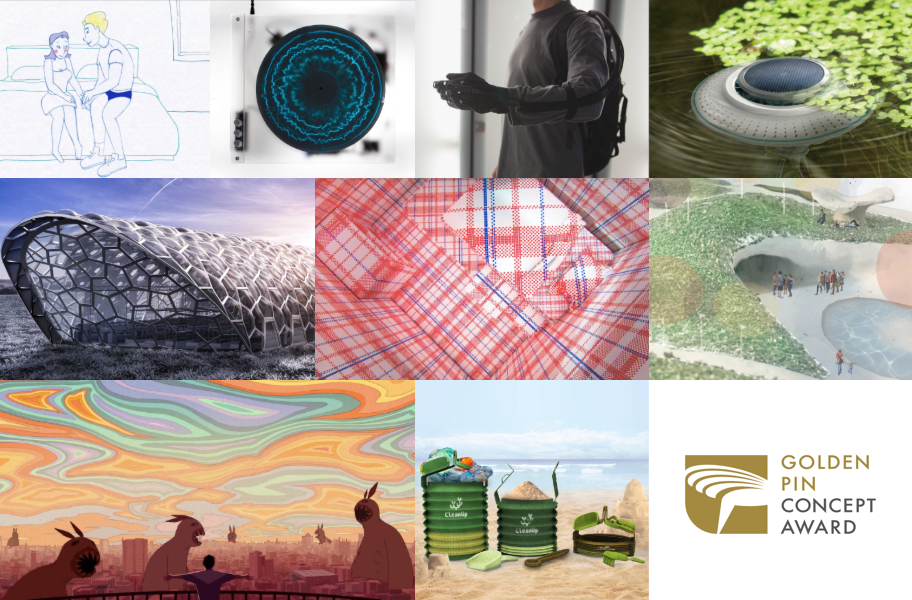
The jury praised the overall standard of concept design on display. Jimmy Chang (Creative Director of UID Create Ltd), David Wang (Founder of bod design corp.), Tony K.M. Chang (Regional Adviser to the World Design Organization), Jui-I Huang (Co-Founder of mistroom), and Shu-Yuan Wu (Director of Motif Planning & Design Consultants) all noted a trend in the concept designs seeking harmony between humanity and nature, reflecting the global movement for sustainability and social design, which has been a recurring theme at the Golden Pin Concept Design Award throughout recent years. Tony K.M. Chang pointed out that the concept designs are catering to a multitude of demographics, including products for elderly and disabled people. Wei-Hsiung Chan (Founder of Business Next Magazine) was impressed by the level of technical ability among the film and animation concept designs, Nice Cheng (Partner at AppWorks) expressed optimism about the market potential for many of the winning product concept designs, while Kuan-Yi Tai (Architect at Kuan-Yi Tai Architects) was impressed with the precision of thought behind many of the concept designs. Together, Ocean Liang (CEO of Inception Cultural & Creative Co., Ltd) and David Wang concluded that if a concept design is mindful of social and environmental responsibility, and can lead society forward in a positive direction, then it will certainly receive praise from the jury. To future entrants, Jui-I Huang and Jamie Wu (CEO of Blueprint Integrate Strategic Design Consultants) encourage designers to think from the user’s perspective, try to empathize with the user’s experiences, and solve problems that the user may encounter.
PRODUCT DESIGN

432Hzzz:「//////」
Designed by Shih-Chen Chen, Wan-Lin Tong, Ting-Kai Chiu, Jia-Heng Liu, and Jun-Yu Chen (Taiwan)
432Hzzz:「//////」 is an album of music for the hearing-impaired. Vibrations from the speaker are visualized by a laser beam and projected onto custom-made acrylic discs, thus representing the audio in a visual form. The three custom-made acrylic disks are designed to correspond with three audio tracks, perfectly representing the feelings and emotions of each different track.
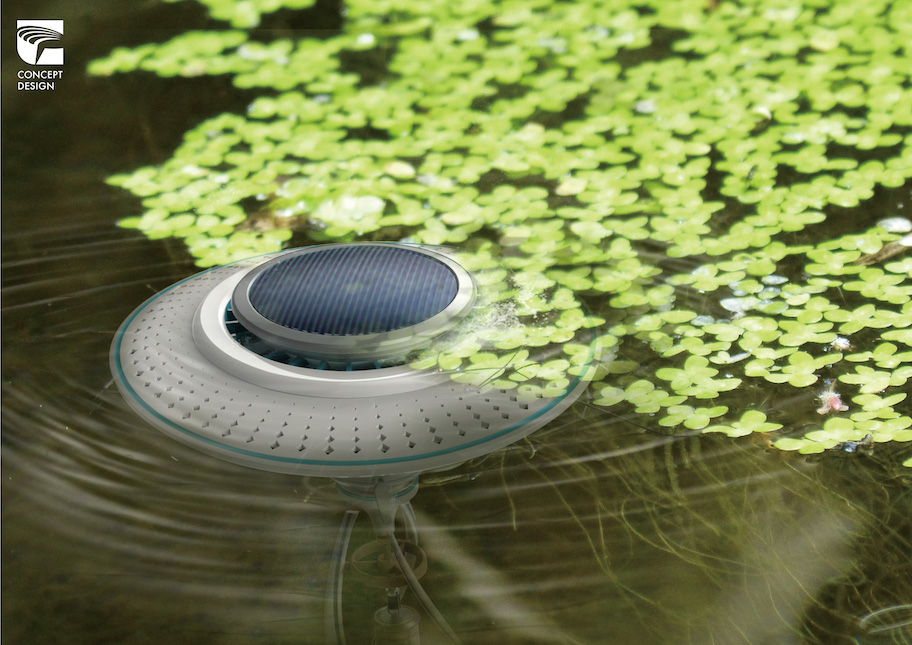
Water Quality Protection
Designed by Yong-Xiang Lin and Tzu-Hsuan Huang (Taiwan)
Water quality protection is a device for removing algae from waterways and collecting data about water quality. Algae grows in stagnant water, and can be harmful to both humans and animals, contaminating water supplies and damaging the marine ecosystem. This device is designed to agitate the water, inhibiting water stagnation and algae growth, while at the same time collecting data about water quality and feeding it back to a centralized system.
INTEGRATION DESIGN
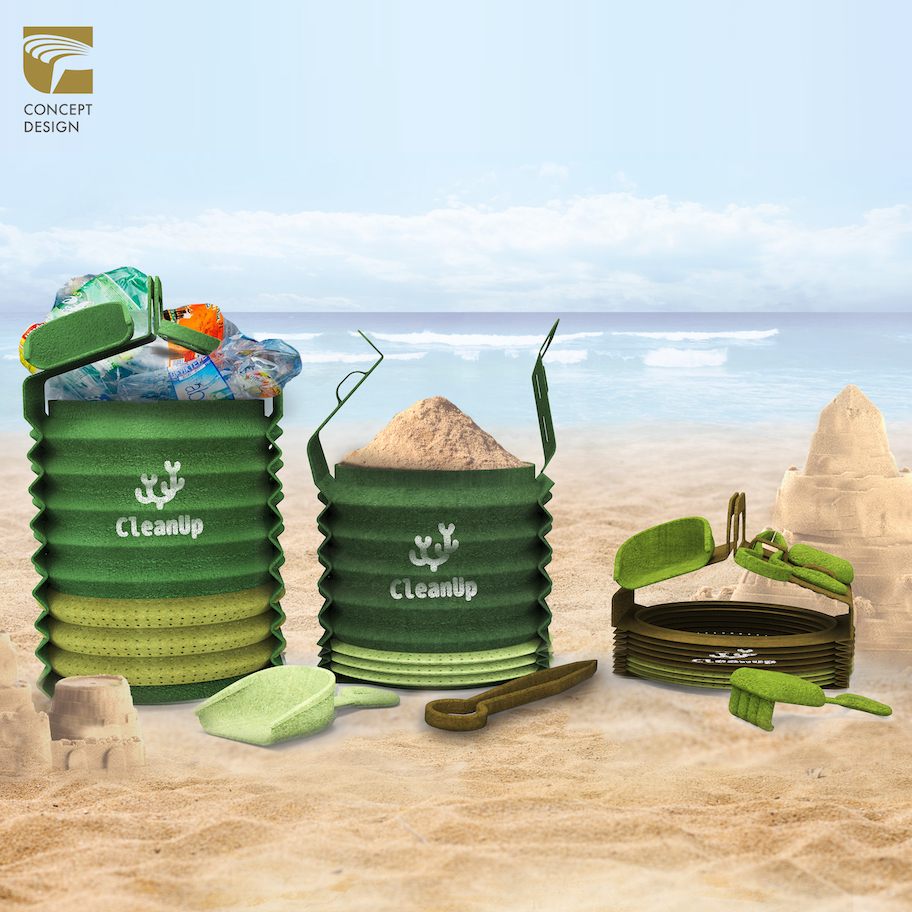
CleanUp
Designed by Chiao-Chi Cheng, Yu-Hsin Li, and Yu-Ting Zeng (Taiwan)
CleanUp is a set of biodegradable beach toys or tools, which includes a stretchable bucket, spade, rake, and clip. They are made from pressed seaweed paper, which is both edible and naturally compostable, meaning they will not pollute the ocean nor damage the food chain when disposed of. They are designed for two purposes; for use as beach toys by children, and also as tools for cleaning up after events.
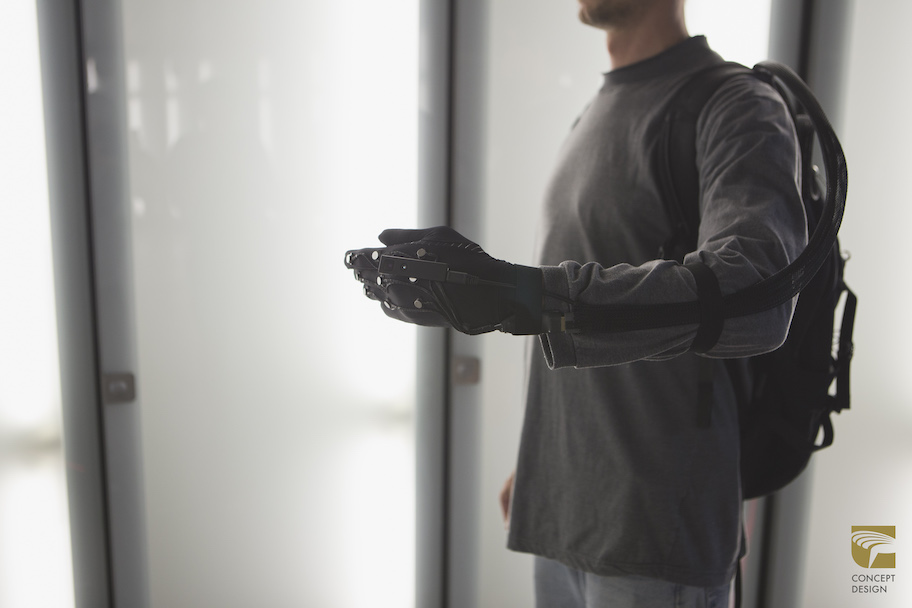
Unfolding Space
Designed by Jakob Kilian (Germany)
Unfolding Space enables its user to see with their hands. A 3D depth sensor takes readings and projects patterns of vibration onto the user’s hand; the location of a vibration depicting an objects relative position in space, and the strength of vibration representing its distance from the user. It is designed to help people with visually impairments to interactively explore their surroundings and orient themselves in unfamiliar environments.
COMMUNICATION DESIGN

City Mark without Label
Designed by Qian-Er Su (China)
City Mark without Label is an exhibition about the migrant workforce in China. Having left behind their rural homes, migrant workers become part of an industrial engine that propels the development of spiraling cities, but never allows them to settle down. The exhibition is designed to assimilate their identity, taking the woven patterned material from the bags they use to carry their belongings, and refashioning it as an interior space.

TUZI
Designed by Ye-Ming Han, Ruo-Fan Tang, and Si-Yue Cheng (China)
TUZI is an animation about a boy who grows up with psychological trauma, having experienced domestic violence as a child. A rabbit comes to symbolize the boy’s traumatic experience, beginning as an innocent pet in his childhood, and maturing into a monster whose rage is unleashed when provoked by bullies. The animation is designed to raise awareness about the lifelong trauma experienced by victims of domestic violence.
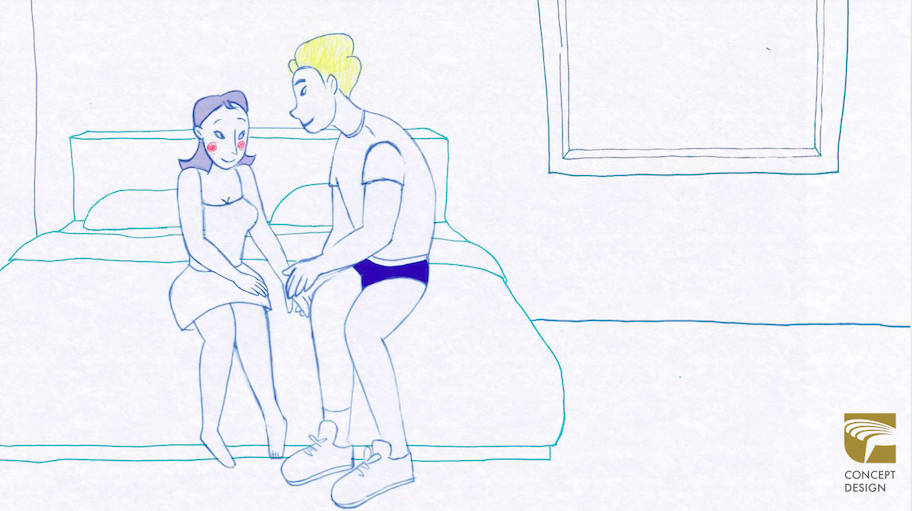
AIR
Designed by Min-Hao Hu (Singapore)
AIR is an animation set in an apartment block, which is home to a couple, a drug addict, a depressed man, and a suicidal office worker. In the story, everyone just wants to be happy and each person finds their own way to attain satisfaction. The animation is designed to demonstrate a certain familiarity between people’s desires and ambitions, however different their means of fulfillment may be.
SPATIAL DESIGN
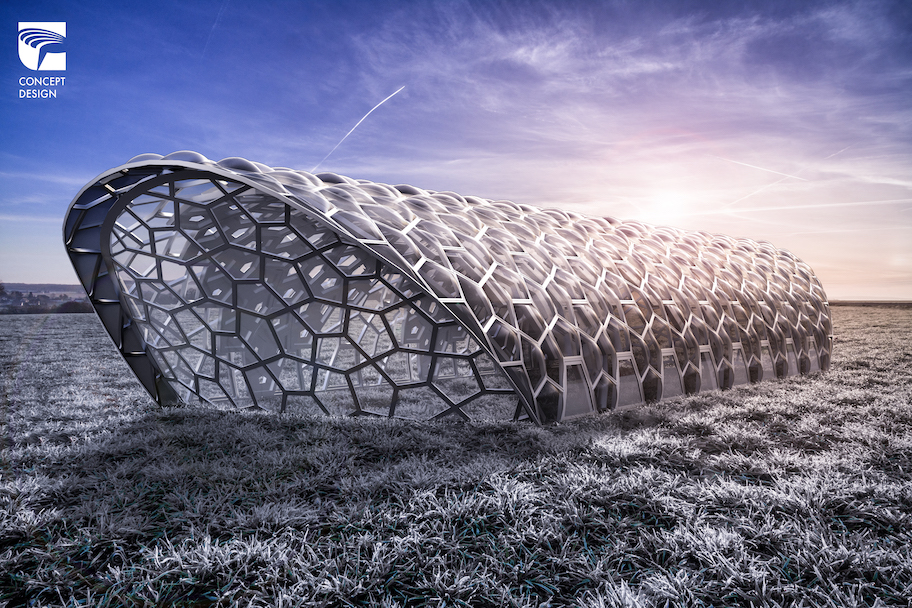
Snow Defender
Designed by Jhe-Wei Lin and Jui-Feng Tang (Taiwan)
Snow Defender shelters crops from the ice and snow in extreme cold-weather conditions. The shelter is made from an azobenzene material, which naturally stores heat when exposed to sunlight and releases it when the sun goes down, balancing the temperature between night and day. It is designed to enable all-year-round crop cultivation in the coldest climates of the Earth and potentially on other planets too.
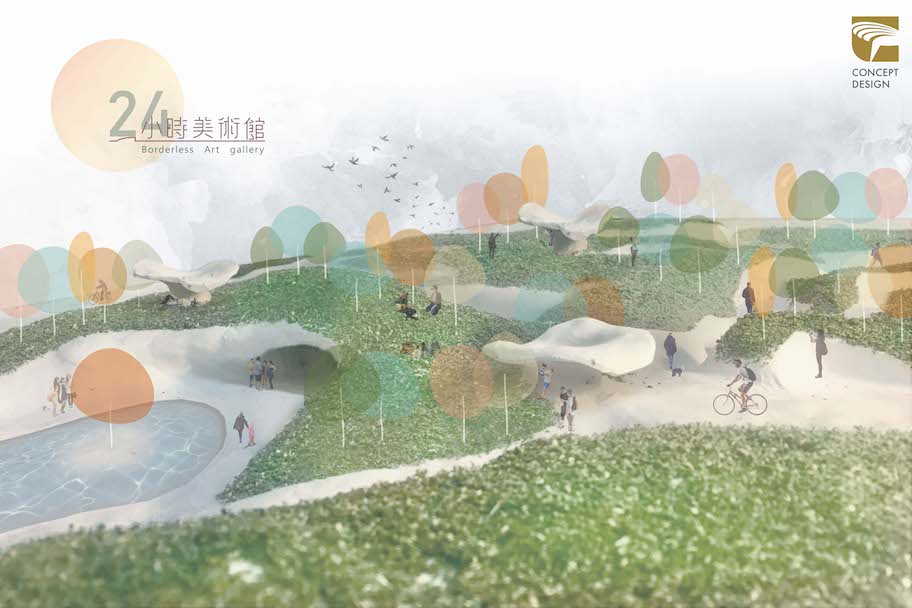
Borderless Art Gallery
Designed by Leng-Ni Chen (Taiwan)
Borderless Art Gallery envisions a 24-hour public art gallery. The 24-hour model is being adopted by more and more businesses in Taipei and other cities around the world, dissolving boundaries within public space and resulting in this concept of borderless-ness. This gallery concept is designed to bring art into the public space, breaking down the boundaries between art and everyday life.
About the Golden Pin Design Award Group
The annual Golden Pin Design Award is the longest-running international design award that celebrates products or projects expressly created for and within huaren (Chinese-speaking) communities, offering entrants an unprecedented opportunity to prove their prowess in the world’s largest market.
The Golden Pin Design Award Group is comprised of two international awards — the Golden Pin Design Award, the Golden Pin Concept Design Award — and the Young Pin Design Award for students in Taiwan. The Golden Pin Design Award Group is executed by the Taiwan Design Center and organized by the Industrial Development Bureau, Ministry of Economic Affairs. The Ministry of Economic Affairs acts in an advisory capacity.
For more insight into designing for Chinese-speaking communities, visit: designperspectives.org/
For the latest news on the Golden Pin Design Award, visit:
Official Website: goldenpin.org.tw/en/
Facebook: facebook.com/GoldenPinDesign/
Instagram: instagram.com/goldenpindesign
Weibo: weibo.com/GoldenPinDesign
WeChat: 金点设计奖
For the latest news on the Golden Pin Concept Design Award, visit:
Official Website: GoldenPin.org.tw/en/
Facebook: facebook.com/GoldenPinConcept/
Instagram: instagram.com/GoldenPinConcept/
Weibo: weibo.com/GoldenPinDesign
WeChat: 金点设计奖
